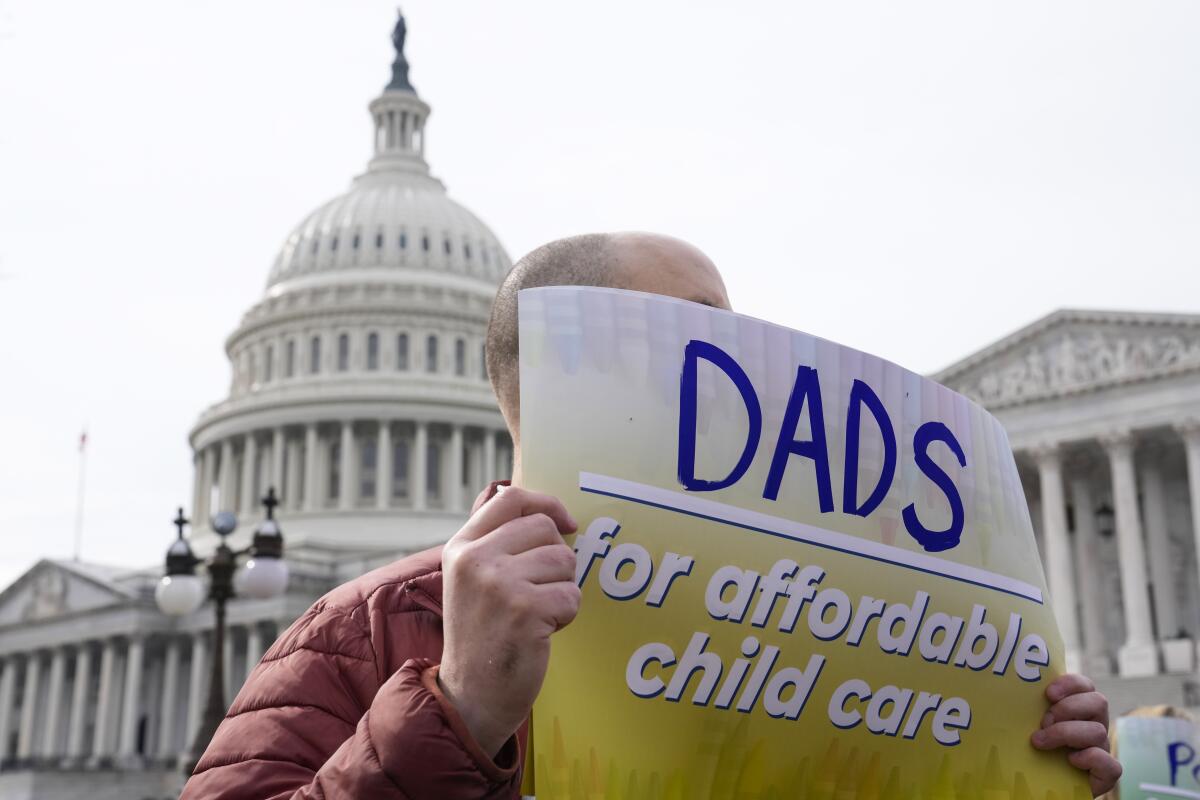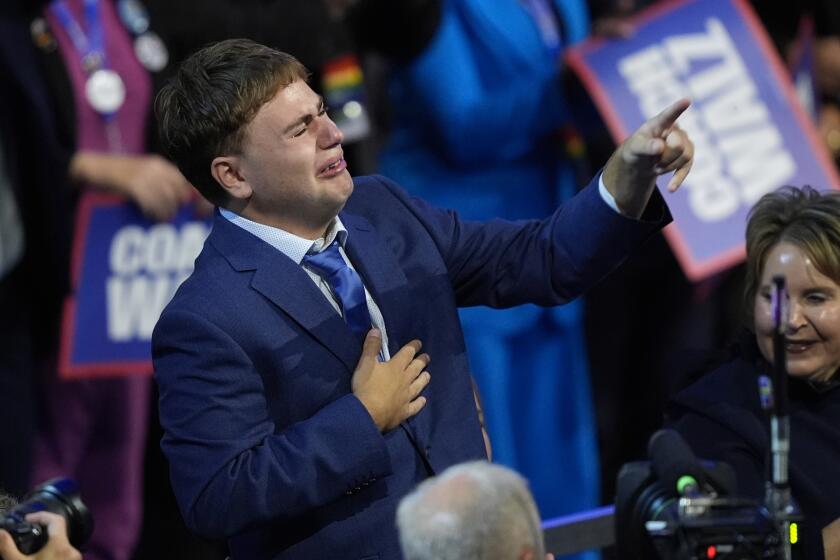Column: What Donald Trump’s incomprehensible word salad about child care revealed

- Share via
In the United States, most parents of young children work, most need help caring for their children, and most cannot depend on family members to pitch in.
So wouldn’t you think that providing affordable, high-quality child care to American families is a no-brainer? I mean, we’ve done it before. Why can’t we do it again?
Indulge me for a brief history lesson:
Eighty years ago, when American GIs were fighting fascism overseas, women were recruited in droves to work in shipyards and factories, where they filled all sorts of jobs traditionally held by men. More than 6 million women worked as welders, operated heavy machinery and did other factory work. They made tanks, ships and planes. Three million women volunteered with the Red Cross. More than 200,000 served in the military.
Minnesota Gov. Tim Walz’s son had a touching and telling reaction to his Democratic convention speech. It made for a stark contrast with Donald Trump and JD Vance.
And who took care of their babies and toddlers? For the first and only time in American history, Congress spent tens of millions of dollars to fund universal child care, enabling state governments and private companies to create hundreds of workplace “war nurseries.” An estimated 550,000 young children were enrolled in them, allowing their mothers to become full-fledged citizens.
On the West Coast, the industrialist and healthcare visionary Henry J. Kaiser hired child development experts to set up what became model versions of child-care centers at his shipyards. The experts tested theories that helped inform and expand the field of early-childhood education.
When the war ended, however, the federal money dried up. All those Rosie the Riveters were banished back to their kitchens, even though a majority wanted to keep their jobs.
The former president’s campaign tried to exploit the hallowed military cemetery and the deaths of service members in Afghanistan for partisan purposes.
The culture then invented the fairy tale that a woman’s true fulfillment comes from motherhood and homemaking, a notion that reached its apogee in the 1950s and early ’60s. The 1963 publication of Betty Friedan’s “The Feminine Mystique” helped pierce that myth and nudge the country into the second wave of American feminism.
In 1971, as more women were entering the workforce again, Congress passed the Comprehensive Child Development Act. It’s almost shocking to contemplate it today: The bill authorized a multibillion-dollar national day-care system designed partly to help working single parents reduce their dependence on welfare.
The groundbreaking legislation soon fell victim to Cold War anxieties: Critics said it would “Sovietize” American children and allow the government to control families. (When you think of how Republicans have rolled back reproductive rights, this is laughable.) President Nixon vetoed the bill.
And here we are today, mired in a patchwork system of child care that is sometimes affordable or high-quality but is almost never both.
Which brings us to the presidential race.
Last week, former President Trump was asked what specific piece of legislation he would advance to make child care affordable. His rambling, incoherent answer was so bizarre and off-point that it went viral.
When his running mate, Ohio Sen. JD Vance, was asked a similar question, the answer was more coherent but almost as strange. After urging grandparents and other relatives to pitch in more, Vance falsely suggested that child-care providers are over-regulated and required to have “a six-year college degree.” (In fact, most child-care providers are women who do not have college degrees and are woefully underpaid.) Vance has characterized universal child care as “class warfare against normal people.”
Trump does not address child care specifically in his platform. Instead, he vows to promote a culture “that values the Sanctity of Marriage, the blessings of childhood, the foundational role of families.” He further promises to “end policies that punish families.”
Project 2025, the Heritage Foundation blueprint for a second Trump term, says nothing about high-quality, affordable child care, but it does call for eliminating the Department of Education and preschool programs such as Head Start, a cornerstone of President Lyndon B. Johnson’s War on Poverty.
By contrast, Vice President Kamala Harris has called for increasing the child tax credit from $2,000 per child to $3,600, which Republicans oppose. She also has proposed a new $6,000 benefit for parents of newborns. Her platform calls for access to high-quality, affordable child care, provided by workers who earn a living wage.
During a Senate subcommittee hearing last year about the expiration of billions of dollars of pandemic-era child-care funding, Louisiana Republican Sen. John Kennedy said that opposing affordable child care “is like being opposed to golden retrievers.” But, he asked labor economist Kathryn Anne Edwards, an expert on the child-care crisis, how on Earth should we pay for it?
She was succinct: “The majority of federal revenue comes from taxes, so if you need more money, you’ll have to raise taxes. I’ll remind you, sir, that we have had two massive, trillion-dollar tax cuts in the past 20 years, and they have done nothing to make child care more affordable. ... They have not been invested in children.”
That is the reality of child care in America. We all want it, but those who control the purse strings refuse to pay for it.
More to Read
A cure for the common opinion
Get thought-provoking perspectives with our weekly newsletter.
You may occasionally receive promotional content from the Los Angeles Times.













